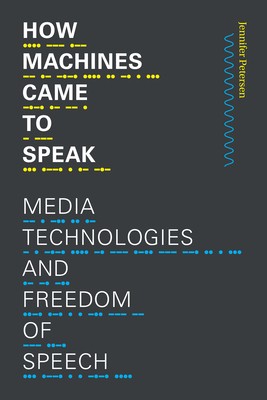
- We will send in 10–14 business days.
- Author: Jennifer Petersen
- Publisher: Duke University Press
- ISBN-10: 1478014520
- ISBN-13: 9781478014522
- Format: 15.2 x 22.6 x 1.8 cm, minkšti viršeliai
- Language: English
- SAVE -10% with code: EXTRA
Reviews
Description
In How Machines Came to Speak Jennifer Petersen constructs a genealogy of how legal conceptions of "speech" have transformed over the last century in response to new media technologies. Drawing on media and legal history, Petersen shows that the legal category of speech has varied considerably, evolving from a narrow category of oratory and print publication to a broad, abstract conception encompassing expressive nonverbal actions, algorithms, and data. She examines a series of pivotal US court cases in which new media technologies--such as phonographs, radio, film, and computer code--were integral to this shift. In judicial decisions ranging from the determination that silent films were not a form of speech to the expansion of speech rights to include algorithmic outputs, courts understood speech as mediated through technology. Speech thus became disarticulated from individual speakers. By outlining how legal definitions of speech are indelibly dependent on technology, Petersen demonstrates that future innovations such as artificial intelligence will continue to restructure speech law in ways that threaten to protect corporate and institutional forms of speech over the rights and interests of citizens.
EXTRA 10 % discount with code: EXTRA
The promotion ends in 23d.03:24:21
The discount code is valid when purchasing from 10 €. Discounts do not stack.
- Author: Jennifer Petersen
- Publisher: Duke University Press
- ISBN-10: 1478014520
- ISBN-13: 9781478014522
- Format: 15.2 x 22.6 x 1.8 cm, minkšti viršeliai
- Language: English English
In How Machines Came to Speak Jennifer Petersen constructs a genealogy of how legal conceptions of "speech" have transformed over the last century in response to new media technologies. Drawing on media and legal history, Petersen shows that the legal category of speech has varied considerably, evolving from a narrow category of oratory and print publication to a broad, abstract conception encompassing expressive nonverbal actions, algorithms, and data. She examines a series of pivotal US court cases in which new media technologies--such as phonographs, radio, film, and computer code--were integral to this shift. In judicial decisions ranging from the determination that silent films were not a form of speech to the expansion of speech rights to include algorithmic outputs, courts understood speech as mediated through technology. Speech thus became disarticulated from individual speakers. By outlining how legal definitions of speech are indelibly dependent on technology, Petersen demonstrates that future innovations such as artificial intelligence will continue to restructure speech law in ways that threaten to protect corporate and institutional forms of speech over the rights and interests of citizens.


Reviews